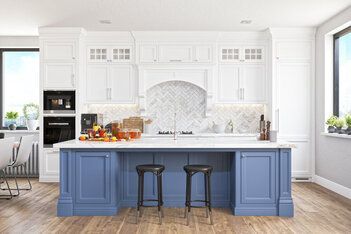Whittier House Painters

Navigating home improvement projects with contractors can be a rewarding journey when approached with the right mindset and strategies. Whether you're renovating a kitchen, remodeling a bathroom, or embarking on a painting project, the key to success lies in fostering effective collaboration. In this blog, we'll explore valuable insights and practical tips to help you seamlessly work with painting contractors, ensuring your projects are executed smoothly and to your satisfaction. From setting clear expectations to maintaining open communication, we've got you covered on the path to success.
1. Define Your Project Goals: Start by clearly defining your project goals. Determine the scope of work, including which areas of your home will be painted, the type of paint and finish you want, any color preferences, and your budget. Consider any specific needs, such as repairs or surface preparation.
2. Research and Select a Reputable Painting Contractor:
Take the time to research and select a reputable painting contractor. Ask for recommendations from friends, family, or online reviews. Obtain quotes from multiple contractors, compare their proposals, and check their credentials, licenses, and insurance. Choose a contractor with a track record of delivering quality work.
3. Obtain a Detailed Written Contract:
Once you've selected a painting contractor, ensure that you have a detailed, written contract in place. The contract should outline all project details, including the scope of work, materials to be used, project timeline, payment schedule, warranties, and any specific agreements you've made. Review the contract carefully and make sure you understand all terms.
4. Set Clear Expectations:
Communicate your expectations clearly to the painting contractor. Discuss your preferred paint colors, any specific techniques or finishes, and any areas of concern. Be sure to address any potential challenges or issues that may arise during the project.
5. Develop a Project Timeline:
Work with the contractor to create a project timeline that outlines when each phase of the project will be completed. A well-defined timeline helps keep the project on track and ensures that both you and the contractor are aware of key milestones.
6. Prepare the Space: Before the painting begins, prepare the space by removing furniture, decor, and personal items from the area to be painted. Cover or protect any items that cannot be moved. Ensure that the workspace is clear to allow the painters to work efficiently.
7. Supervise the Project: Stay actively involved in the project by supervising the work regularly. Inspect the progress at various stages, such as surface preparation, priming, and painting. Address any concerns or issues promptly to ensure they are resolved in a timely manner.
8. Maintain Open Communication:
Maintain open and frequent communication with the painting contractor throughout the project. Discuss any changes or adjustments that may be needed and provide feedback on the work. Good communication fosters a positive working relationship and ensures that everyone is on the same page.
9. Address Any Concerns Promptly:
If you have any concerns or issues during the project, address them promptly with the painting contractor. A professional contractor will be responsive and willing to address your concerns and make necessary corrections.
10. Final Inspection and Walk-Through:
Once the painting project is completed, conduct a final inspection and walk-through with the contractor. Ensure that all work has been completed to your satisfaction, and any touch-ups or corrections have been made.
11. Final Payment: Release the final payment only after you are fully satisfied with the completed project and all aspects of the contract have been met.
12. Maintain Records:
Keep records of all project-related documents, including the contract, payment receipts, and any warranties provided by the painting contractor. These records may be useful for future reference or in case of any issues that arise later.
By following this approach, you can effectively manage your painting project, ensure a smooth process, and achieve the desired results that enhance the beauty and value of your home. Effective project management and clear communication are key to a successful painting experience.
The Art of Home Transformation: Selecting the Perfect House Painting Color Palette for Your Space

Your home is more than just walls and a roof; it's a canvas for self-expression and a reflection of your personality. One of the most impactful ways to personalize your living space is through the use of color. The right house painting color palette can breathe life into your home, creating an atmosphere that resonates with you and your family. In this blog, we'll explore the importance of selecting the perfect colors for your home and guide you through the process.
The Power of Color: Why It Matters
Color is a potent tool that can influence our emotions, behaviors, and overall well-being. When chosen thoughtfully, it can transform a room, evoke specific moods, and even make spaces appear larger or cozier. Here's why selecting the right colors for your home is crucial:
- Reflecting Your Personality: Your home should be a reflection of who you are. Choosing colors that resonate with your personality and style creates a space that feels uniquely yours.
- Setting the Mood: Different colors have distinct psychological effects. For instance, cool blues and greens can evoke calmness, while vibrant reds and yellows can energize a room. Understanding these effects helps you set the desired mood in each space.
- Enhancing Functionality: Colors can also impact how we perceive space. Lighter colors can make a room feel more spacious, while darker tones can create coziness and intimacy. This knowledge can help you optimize the functionality of your rooms.
- Connecting Spaces: A well-thought-out color scheme can create flow and harmony throughout your home, making it feel cohesive and inviting.
Choosing the wrong paint color for your home can be a costly and frustrating mistake. Here are the top three mistakes people make when selecting paint colors:
- Not Testing Samples in the Actual Space: One of the most common mistakes is not testing paint samples in the actual room where they will be applied. Paint colors can look drastically different under different lighting conditions, and what appears perfect in a paint store may not work well in your home. Natural light, artificial lighting, and the colors of your existing furnishings can all influence how a paint color appears. To avoid this mistake, always paint a small sample area on your wall and observe it at different times of the day before making your final choice.
- Ignoring Undertones: Every paint color has undertones, which are subtle shades within the color that can be warm, cool, or neutral. Ignoring these undertones can lead to a mismatch with your existing decor or create an unintended mood in the room. For example, a gray paint with warm undertones may clash with cool-toned furnishings. To avoid this mistake, pay attention to the undertones of your chosen paint color and ensure they harmonize with your decor.
- Rushing the Decision: Choosing a paint color should not be rushed. Many people make the mistake of picking a color quickly without considering the overall color scheme of their home or how the chosen color will affect the room's ambiance. Rushing the decision can lead to regrets and the need for repainting. Take the time to research, sample, and envision how the color will work in your space. Don't make impulsive choices that you might later regret.
By avoiding these common mistakes and taking a thoughtful, patient approach to choosing paint colors, you can ensure that your home's color scheme enhances its beauty and reflects your personal style effectively. By following the steps below, you can be confident with your color choices for a vary long time.
The Process of Choosing the Perfect Colors
Now that we understand why selecting the right colors is essential, let's delve into the step-by-step process of choosing the perfect color palette for your home:
1. Start with Inspiration:
Begin by gathering inspiration from various sources. Explore home decor magazines, browse through Pinterest, visit paint stores, or even take a walk in nature. Pay attention to colors that catch your eye and evoke positive emotions.
2. Consider the Room's Purpose:
Each room in your home serves a different purpose, and the color palette should align with that function. For instance:
Bedrooms benefit from calming and soothing colors like soft blues, greens, or muted grays.
Kitchens can embrace warm and inviting hues like earthy tones or cheerful yellows.
Home offices may benefit from energizing colors like soft oranges or light blues.
3. Assess Lighting Conditions:
Natural and artificial lighting can significantly impact how colors appear in a room. Consider the direction and intensity of sunlight, as well as the type of artificial lighting you use. Test paint samples under different lighting conditions to ensure the chosen colors look as expected.
4. Create a Cohesive Flow:
Maintaining a sense of unity throughout your home is vital. Choose a primary color that will serve as the backbone of your color scheme. Then, select complementary colors and accents that harmonize with the primary choice. This approach ensures a cohesive flow from room to room.
5. Sample the Colors:
Never underestimate the importance of paint samples. Most paint stores offer small sample cans or peel-and-stick swatches. Apply samples to a small section of your wall to see how they look in your specific space. Be sure to observe them at different times of the day to assess how lighting affects them.
6. Test for Compatibility:
Consider how your chosen color palette will work with existing furniture and decor. Do they complement or clash? If necessary, make adjustments to your decor to ensure everything works harmoniously.
7. Seek Expert Advice:
If you're uncertain about your choices or need additional guidance, consult with a professional interior designer or a color consultant. They can provide expert insights and help you make confident decisions.
8. Think About Longevity:
Trends come and go, but classic colors stand the test of time. While it's essential to stay true to your style, consider selecting timeless colors for your larger, more permanent elements like walls and furniture. You can then add trendy accents through decor items, which are easier to update.
9. Observe Psychological Effects:
Remember that colors have psychological effects. Consider how different colors might impact your mood and behavior in a particular space. For example:
- Soft blues and greens promote relaxation and focus.
- Warm yellows and oranges encourage socialization and energy.
- Neutrals like grays and beiges offer versatility and sophistication.
10. Balance Warm and Cool Tones:
Achieving the right balance between warm and cool tones is crucial. Too much of one or the other can disrupt the overall atmosphere. Mix warm and cool colors to create a visually appealing and balanced space.
11. Don't Rush the Decision:
Choosing the perfect color palette is a process that requires time and consideration. Avoid rushing your decisions, and be patient with the sampling and testing phases. Take your time to ensure you're truly satisfied with your choices.
12. Embrace Personalization:
Ultimately, your home should reflect your unique personality and style. Don't be afraid to embrace unconventional colors or unique combinations if they resonate with you. Your home is a canvas for self-expression.
The Stress of Too Many Choices!
A well-designed color palette creates a wonderful living environment, yet it’s no secret that selecting interior paint colors can indeed be overwhelming, especially with the countless options available. If you find yourself feeling overwhelmed, here are some steps to help you navigate the process more effectively:
- Gather Inspiration: Look for inspiration in magazines, websites, social media platforms (such as Pinterest and Instagram), and even in nature. Create a mood board or folder with images of rooms or color schemes that resonate with you. This will help you identify patterns and preferences.
- Sample Paint Colors in Multiple Shades: Paint samples are your best friend. Most paint stores offer small sample cans or peel-and-stick swatches. Purchase a few samples of colors you're considering and apply them to a small section of your wall. Observe how they look at different times of the day and under various lighting conditions. Don't limit yourself to a single shade of the same color. Test several shades within the same color family to see which one works best. The subtle differences in undertones can have a significant impact on the overall feel of the room.
- Consult Experts: Interior designers and color consultants specialize in helping people choose the right colors for their spaces. If you're truly stuck, consider seeking professional guidance. They can provide valuable insights and make the process less overwhelming. Whittier House Painting offers a Color Consultation service that will help ensure your painting refresh is stress free experience with a wonderful outcome. To find out more about our Color consult Service, call NUMBER.
Choosing the perfect color palette for your home is an art form that can have a profound impact on your daily life. It's a journey of self-discovery, creativity, and personalization. By following these steps and considering the importance of color, you can transform your living spaces into a haven that reflects your personality and creates the ambiance you desire.
AREAS WE SERVE
Whittier, CA
South Whittier, CA
Pico Rivera, CA
Santa Fe Springs, CA
Hacienda Heights, CA
La Mirada, CA
East La Mirada, CA
Avocado Heights, CA
El Monte, CA
Montebello, CA
La Puente, CA
La Habra, CA
Norwalk, CA
El Monte, CA
West Puente Valley, CA
Downey, CA
COMPANY INFO
